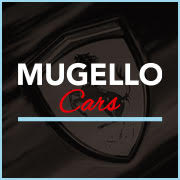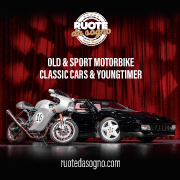Chassis No. ZFFGJ34B000084250 Engine No. 21078 The F40 was created as a declaration—the final word from Enzo himself on what a Ferrari should be. Conceived to honor the company’s 40th anniversary, it was both a gift to the company and the Tifosi and a symbol of what Maranello had achieved in four decades of racing and road car excellence. No champagne toast, no sentimental speeches—just a machine built to embody everything Ferrari stood for. In the years before its debut, rumors swirled as camouflaged Ferraris were seen pounding laps at Fiorano. Many assumed these prototypes were destined to succeed the 288 GTO. In truth, they were the 288 GTO Evoluzione, conceived for Group B racing before the series’ abrupt cancellation. Suddenly stripped of a purpose, the Evoluzione became experimental test beds for something more ambitious—a 40th-anniversary road car. Though purposeful in appearance, those five Evoluzione cars bridged the gap between the GTO and the machine that would carry Enzo’s signature into legend: the F40. The public unveiling came on 21 July 1987 in Maranello. Enzo Ferrari, older but sharp-eyed, attended in person. According to Car and Driver, a microphone picked up his muttered reaction as the cover lifted: “Bello, molto bello.” Theater, yes—but also a rare glimpse of total approval from the man himself. And with good reason. Pininfarina’s design, shaped under Leonardo Fioravanti and honed in the wind tunnel, was purposeful yet captivating. Eleven large composite panels formed the bodywork, with massive clamshells fore and aft that revealed every mechanical detail. NACA ducts, intakes, and scoops were placed with racing intent, feeding air to turbos, brakes, and intercoolers. Even the vast rear wing, an extension of function, became an instant icon. The inside told a different story. Where rivals flaunted leather and computerized technology, the F40 rejected indulgence. Its cockpit was as raw as the race cars it mirrored—cloth racing seats, exposed composites, pull-strap door releases, even sliding Perspex windows on early cars. Ferrari put it plainly: there was no trim, only necessity. The beating heart beneath the rear clamshell was rooted in the 288 GTO’s twin-turbocharged V8, but evolution had been swift. Displacement rose to 2.9 liters, IHI turbos and Behr intercoolers were fitted, and output climbed to 478 CV and 577 Nm of torque. The numbers were staggering for 1987 and paired with a featherweight carbon/Kevlar structure—20 percent lighter and three times stiffer than the GTO—the F40 rewrote the rulebook. Zero to 100 km/h arrived in 4.1 seconds, and its top speed was an incredible 324 km/h, crowning the F40 the fastest road car in the world. Ferrari originally announced 400 units, but demand proved insatiable. By the time production ended in 1992, about 1,315 examples had been built. Yet among them, purists recognize a hierarchy. The earliest cars, delivered before regulations softened the formula, are known as “non-cat, non-adjust.” Free of catalytic converters and the self-leveling suspension, these versions retained the F40’s most unfiltered character—lighter, sharper, and breathing without restriction. Today, they are regarded as the most coveted, the closest to the raw vision Enzo Ferrari intended. F40 chassis number 84250 is, indeed, a coveted “non-cat, non-adjust” model. According to its original service book, it was imported by Ferrari Deutschland and first sold via Exclusive Automobile Mayer based in Kleinostheim, Germany, on 19 April 1990 to Dr. Klaus Berg of nearby Karben who, at the same time, also owned the famed one-off Porsche 959 Cabriolet. Quite the pair they must have made! The service book records the good doctor’s F40 was sparingly used with an initial service in August of that year and later a 5,000 km service note in January 1994. In 2011, F40 number 84250 applied for and received its all-important Ferrari Classiche Red Book certification. In it, Ferrari records that the car retains its matching-numbers 2.9-liter twin-turbocharged V8 and that the car retains its original specification. It is believed that the F40 was retained by Dr. Berg before being acquired by Noo Nowvakhet based in Spain. It is believed that Nowvakhet kept the car in Europe while under his ownership. In 2016, likely in preparation for sale, Nowvakhet sent the F40 back to Maranello to have the fuel tank bags replaced at the factory for a total of €36.314. Later that year, in November, the car was acquired by the current owner also based in Spain. While in the consignor’s care, chassis number 84250 has been the subject of regular servicing at Maranello Rosso in Madrid. Detailed invoices on file and available for review document the service work. Beginning in 2019 at 9,191 kilometers, the F40 received a 10,000-km service that included fresh fluids, a new crankshaft seal, a new flywheel and clutch assembly, new engine mounts, and more for a total of €13.531. In February 2023, it received an annual service with a diagnosis, fresh fluids, replacement spark plugs, fuel filters, compression check, new timing belts and tensioners, and an air conditioning charge. In June of that year, it received fresh Pirelli tires, a systems check at 9,776 kilometers in preparation for the F40 35 Anniversario tour in 2023. The tour was an exclusive event held on the most beautiful roads of Provence and a unique opportunity to enjoy the power and poise of this well-maintained example among a number of other significant Ferraris, where it is noted to have acquitted itself impeccably. This F40 represents an exceptionally original, European-delivery F40, coveted in its pure “non-cat, non-adjust” configuration and certified by Ferrari Classiche as a matching-numbers example. First delivered new in Germany in 1990 and later residing in Spain, it has been consistently maintained, including a factory fuel tank service in 2016 and a full suite of recent work with a new clutch, fresh belts, and new tires installed in 2023. The F40 was more than an anniversary model. It was the last Ferrari supercar personally overseen by Il Commendatore, a car born from racing prototypes and shaped by necessity into one of the most uncompromising road cars ever built. This example, which retains its original paint and shows fewer than 10,400 kilometers from new, is perhaps the ideal representative example of Ferrari’s 40th birthday present. It was not only one of the greatest acts of self-gifting in the modern era, but also a reminder that no one builds a supercar like Maranello—and now, this well-preserved and documented example offers a new caretaker the chance to join the celebration.
- Fuel
- Body Types
- Transmission
- Exterior Colour
- Number of doors
- Interior Colour
- VIN CodeZFFGJ34B000084250





































































